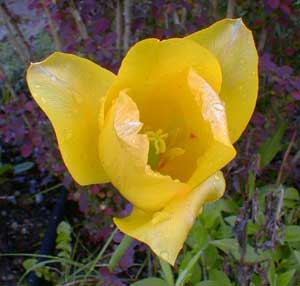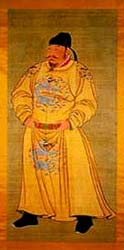
Golden Emperor Tulip
I saw the Divine Shekhinah treading through the night
murmuring, "sela, sela, sela"
meaning, "stone, stone, stone."
I saw Lilith skipping through a sunlit field in Persia
singing "lala, lala, lala,"
meaning "tulip, tulip, tulip."
-j.a.s.,
2004
2004
This Tulipa fosteriana or Emperor Tulip is 'Golden Emperor' aka 'Golden Purissima' aka 'Yellow Emperor,' occasionally sold as Golden or Yellow Empress.
Fosteriana tulips are longlived in the garden, returning for many years. They are early bloomers, of medium height, on average fourteen inches.
The original species tulip from which the whole group was derived was a bright red native of mountainous regions of Turkestan. The first wild red specimens that made it to Holland were collected by Joseph Haberhauer; it would not become widely available in cultivated forms until three decades later. Today's bright red clones which most resemble the wild Fosteriana are sold under the name 'Red Emperor' though it is actually registered as 'Madame Lefeber' after the wife of the Holland grower Dirk Lefeber, who experimented with the species early in the 20th Century & established the first cultivated forms of what became the Fosteriana Group.
 'Golden Emperor' blooms in April, lasting long into May. The sturdy stems are not bothered by wind or rain & stand very upright. The bulbs are placed in autumn six or eight inches deep (measured to the bottom of the bulb), at least four or five inches apart. They open fully only when planted in full sun. They do well in zones 3 through 8, & can withstand rather droughty conditions even during their blooming period, though blooms may be larger with occasional watering.
'Golden Emperor' blooms in April, lasting long into May. The sturdy stems are not bothered by wind or rain & stand very upright. The bulbs are placed in autumn six or eight inches deep (measured to the bottom of the bulb), at least four or five inches apart. They open fully only when planted in full sun. They do well in zones 3 through 8, & can withstand rather droughty conditions even during their blooming period, though blooms may be larger with occasional watering.History's (& myth's) Yellow Emperor was the ancient Taoist philosopher, Huang-ti or Huang Di, founder & first emperor of the Chinese nation, in the 23rd Century B.C.E. "Huang" means Yellow, & "Huangdi" means Emperor, so his name is an affectionate pun. He was the author of the world's oldest surviving medical text, Huang-ti Nei Ching ("The Yellow Emperor's Classic of Medicine").
He is said to have invented the wheeled cart, the slipper boat, bricks & masonry, the magnetic compass, plus his interest in astronomy led to his devising the first Chinese calendar. His wife, Empress Lei Zu, was equally clever. One day sitting under a mulberry tree, a silkworm cocoon fell into her hot tea, from which event she was able to deduce all the methods by which silkworms are raised & their cocoons boiled to be woven into silk cloth. She is regarded as the Taoist Goddess of Silk.